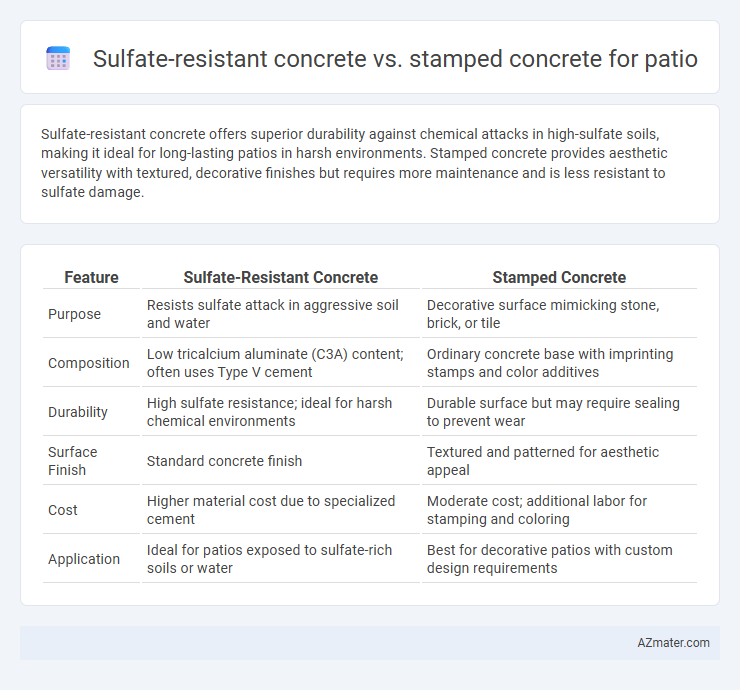Sulfate-resistant concrete offers superior durability against chemical attacks in high-sulfate soils, making it ideal for long-lasting patios in harsh environments. Stamped concrete provides aesthetic versatility with textured, decorative finishes but requires more maintenance and is less resistant to sulfate damage.
Table of Comparison
| Feature | Sulfate-Resistant Concrete | Stamped Concrete |
|---|---|---|
| Purpose | Resists sulfate attack in aggressive soil and water | Decorative surface mimicking stone, brick, or tile |
| Composition | Low tricalcium aluminate (C3A) content; often uses Type V cement | Ordinary concrete base with imprinting stamps and color additives |
| Durability | High sulfate resistance; ideal for harsh chemical environments | Durable surface but may require sealing to prevent wear |
| Surface Finish | Standard concrete finish | Textured and patterned for aesthetic appeal |
| Cost | Higher material cost due to specialized cement | Moderate cost; additional labor for stamping and coloring |
| Application | Ideal for patios exposed to sulfate-rich soils or water | Best for decorative patios with custom design requirements |
Understanding Sulfate-Resistant Concrete
Sulfate-resistant concrete is designed to withstand chemical attacks from sulfate-rich soils or groundwater, making it ideal for patios built in areas with high sulfate content that can deteriorate traditional concrete. This specialized concrete incorporates low C3A (tricalcium aluminate) cement to minimize expansion and cracking caused by sulfate reactions, ensuring enhanced durability and longevity. Unlike stamped concrete, which focuses on aesthetic surface patterns and textures, sulfate-resistant concrete prioritizes structural resilience against aggressive environmental factors.
What Is Stamped Concrete?
Stamped concrete is a decorative concrete technique that mimics the appearance of natural materials such as stone, brick, or wood by imprinting patterns and textures onto freshly poured concrete. This method enhances aesthetic appeal and provides customizable designs suitable for patios, walkways, and driveways. Unlike sulfate-resistant concrete, which prioritizes chemical durability in aggressive environments, stamped concrete focuses on visual appeal and surface texture.
Key Differences Between Sulfate-Resistant and Stamped Concrete
Sulfate-resistant concrete is specifically designed to withstand high sulfate environments by incorporating low C3A cement, making it ideal for patios exposed to aggressive soil or groundwater conditions. Stamped concrete, on the other hand, is primarily decorative, featuring patterns and textures that mimic natural stone or brick, but it lacks specialized chemical resistance. The key difference lies in sulfate-resistant concrete's durability against chemical attacks, whereas stamped concrete prioritizes aesthetic appeal without enhanced sulfate protection.
Durability and Longevity Comparison
Sulfate-resistant concrete offers superior durability in environments exposed to high sulfate concentrations, preventing chemical degradation and ensuring structural integrity over decades. Stamped concrete provides aesthetic appeal with moderate durability but may require regular sealing to protect against wear and environmental damage. For patios in sulfate-rich soils or wetlands, sulfate-resistant concrete ensures longer-lasting performance compared to stamped concrete.
Aesthetic Options: Sulfate-Resistant vs Stamped Patio
Sulfate-resistant concrete offers a durable, uniform surface with limited color and texture variations, primarily designed to withstand harsh chemical environments rather than aesthetic flexibility. Stamped concrete provides a wide array of design possibilities, including intricate patterns and vibrant color blends that mimic natural stone, brick, or wood, making it ideal for visually appealing patios. While sulfate-resistant concrete excels in longevity under corrosive conditions, stamped concrete dominates in customizable aesthetic options for outdoor living spaces.
Cost Analysis for Both Concrete Types
Sulfate-resistant concrete typically incurs higher initial costs due to specialized cement and additives designed to withstand sulfate exposure, making it suitable for aggressive soil environments. Stamped concrete offers a more budget-friendly option with flexible design aesthetics but may require more frequent maintenance and sealing to preserve its appearance. Overall, sulfate-resistant concrete presents a long-term investment with durability benefits, while stamped concrete is cost-effective upfront but can result in higher cumulative expenses over time due to upkeep.
Installation Process and Requirements
Sulfate-resistant concrete for patios requires precise mixing with low C3A cement and strict curing to prevent sulfate attack, demanding skilled labor and careful site preparation for durability in aggressive soil conditions. Stamped concrete installation involves pouring and leveling standard concrete, followed by imprinting patterns and textures using molds before curing, requiring expertise in timing and surface treatment to achieve desired aesthetic effects. Both methods necessitate specific equipment: sulfate-resistant concrete needs quality control tools for chemical composition, whereas stamped concrete requires stamping mats and coloring agents to ensure a uniform, decorative finish.
Maintenance Needs and Long-Term Care
Sulfate-resistant concrete requires minimal maintenance due to its enhanced durability against chemical attacks, reducing the risk of cracking or degradation over time, which is ideal for harsh soil conditions. Stamped concrete, while visually appealing with its decorative patterns, demands regular sealing and cleaning to prevent surface wear, fading, and damage from weather exposure. Long-term care for sulfate-resistant concrete involves periodic inspections without intensive upkeep, whereas stamped concrete benefits from scheduled resealing every 2-3 years to maintain its aesthetic integrity.
Best Applications and Ideal Environments
Sulfate-resistant concrete is best suited for patios in environments with high sulfate soil or groundwater, effectively preventing deterioration caused by chemical reactions. Stamped concrete excels in aesthetic applications where visual appeal and customizable patterns are desired, making it ideal for decorative patios in residential and commercial spaces. Selecting sulfate-resistant concrete ensures durability in aggressive soil conditions, while stamped concrete offers versatility and design flexibility in normal environments.
Deciding Which Concrete is Best for Your Patio
Sulfate-resistant concrete offers enhanced durability against soil and water sulfate attacks, making it ideal for patios in areas with high sulfate concentrations, while stamped concrete provides customizable aesthetics with patterns and textures that mimic natural materials. Selecting the best concrete depends on your patio's environmental conditions and design preferences; sulfate-resistant concrete ensures longevity and structural integrity, whereas stamped concrete prioritizes visual appeal and surface versatility. Evaluating local sulfate soil levels and maintenance expectations will guide the optimal choice for a resilient and beautiful patio.

Infographic: Sulfate-resistant concrete vs Stamped concrete for Patio
 azmater.com
azmater.com